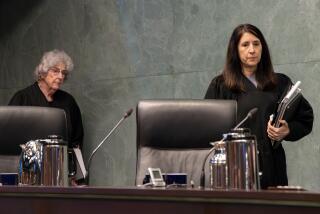Ruling Finds Bias Against Older State Workers
A federal appeals court ruled Wednesday that a California law discriminates against older state workers who are injured on the job but receive lower disability benefits than their younger colleagues.
The U.S. 9th Circuit Court of Appeals in San Francisco held that the law violates federal rules prohibiting age discrimination. This 19-year-old law spells out how benefits should be calculated for injured police officers, firefighters and other so-called safety employees.
The decision reinstates a class-action lawsuit by a group of former state employees who said the state’s disability system provided lower payments to employees hired at older ages, regardless of their years of service.
“This is a great victory for older workers,” said Ellen Lake, an Oakland attorney who represented the injured state workers in their appeal. “It’s a victory for the practice of treating all employees on their merits.”
The law has also come under attack from the federal Equal Employment Opportunity Commission and the American Assn. of Retired Persons, which both filed friend-of-the-court briefs in the case.
On Wednesday, EEOC attorneys said the ruling could have broader implications, even for private employers.
“Employers are on notice that benefits should be doled out [equitably], not based on age,” said Lorraine Davis, an EEOC attorney in Washington.
The appellate panel’s decision also means that the California Public Employees’ Retirement System, which administers state disability benefits, may have to rethink how it calculates disability payments for some older state employees.
Before 1980, all safety employees who retired on disability received 50% of their final monthly pay. The same year, the state legislature passed the California Public Employees Retirement Law which, among other things, considered an employee’s “potential years of service” in calculating disability payments.
The change affected older workers the most. For example, if a 25-year-old officer and a 45-year-old colleague were hired on the same date and became disabled in the same accident, the younger employee would receive 50% of final pay from then on, while the older worker would get only 20%.
A group of former state employees challenged the practice in a class-action suit that was eventually dismissed by a federal judge in San Francisco.
CalPERS, the nation’s largest pension fund, defended the disability system. The fund’s attorneys argued that the system presumed that younger workers do not have other resources to rely on, “unlike an employee who begins work in the public sector later in life.”
They also said older employees cannot complain about lower disability benefits because they “voluntarily” chose to begin work at a later age.
“This argument . . . ignores the reality of the modern work force,” wrote M. Margaret McKeown for a unanimous three-judge panel.
Said McKeown, “It is unquestionable that employees would have received greater disability retirement benefits but for their older ages at hire.”
More to Read
Get the L.A. Times Politics newsletter
Deeply reported insights into legislation, politics and policy from Sacramento, Washington and beyond. In your inbox three times per week.
You may occasionally receive promotional content from the Los Angeles Times.










